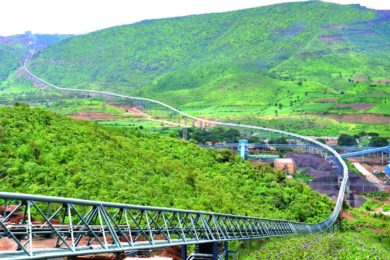 As South African safety, health and environmental legislation continues to tighten, Weba Chute Systems reports increased interest in its bulk materials handling equipment, which significantly reduces noise and dust pollution and lowers energy consumption, while extending the traditional lifecycle of this category of equipment. Weba Chute Systems’ technical director Alwin Nienaber says the locally manufactured Weba Chute System is designed according to the principle of conveyed material impacting on surfaces which already contain material.
As South African safety, health and environmental legislation continues to tighten, Weba Chute Systems reports increased interest in its bulk materials handling equipment, which significantly reduces noise and dust pollution and lowers energy consumption, while extending the traditional lifecycle of this category of equipment. Weba Chute Systems’ technical director Alwin Nienaber says the locally manufactured Weba Chute System is designed according to the principle of conveyed material impacting on surfaces which already contain material.
“Using a cascade system to create a ‘super-flow’ effect, we are able to reduce volumes of unwanted fines and associated dust,” Nienaber says, who describes the technology as “a streamlined scientific approach to the dynamics of bulk materials handling at transfer points.” The immediate decrease in dust and noise pollution enhances working conditions and impacts positively on the health of workers. Nienaber points out that most dust is generated when material is transferred. “For this reason, we don’t simply install extractive equipment but study the whole work process, identifying the source of the dust problem and then custom-designing a transfer system specifically aimed at reducing and preferably, eliminating volumes of dust,” he says. “Consequently, there is less demand for powerful extraction equipment, which results in genuine cost savings.”
According to the company, Weba Chute Systems are proving a very efficient alternative to other dust control methods, reducing dust levels in some applications to less than 95% of visible dust, without the use of skirtboards, dust seals and extended covers. Weba Chute Systems control the direction, flow and velocity of the calculated volume and type of material in each application, also taking into account belt width, belt speed, material sizes, shape and throughput. “Each Weba Chute System is designed for customer-specific applications and requirements,” Nienaber says. “The recommended approach is to design the Weba Chute System during the initial phase of new projects to maximise benefits, but many customers who recognise the numerous benefits, also retrofit the equipment very successfully to existing installations. To date, more than 3 000 installations, handling a variety of different materials have been implemented throughout South Africa.








